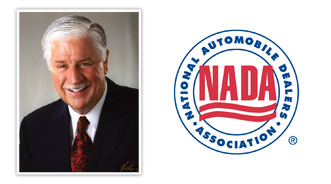Wade: Study on Store Renovation Benefits to be Comprehensive, Wide-Ranging

By subscribing, you agree to receive communications from Auto Remarketing and our partners in accordance with our Privacy Policy. We may share your information with select partners and sponsors who may contact you about their products and services. You may unsubscribe at any time.
DETROIT –
Independent auto consultant Glenn Mercer’s study will comb through confidential interviews with dealers, lawyers, accountants and automakers, among others. Part of the process will be to reach out to outside industries — like the restaurant and hotel businesses — to seek their input.
All of this will be done to address a point of “frustration” among dealers that is consistently expressed to National Automobile Dealers Association chairman Stephen Wade: the financial burden of OEM-mandated dealership facility facelifts.
As reported earlier in Auto Remarketing, Wade contends there is not much empirical proof indicating the actual return-on-investment for these projects for dealers or automakers. To solve this problem, NADA has asked Mercer — a former partner with McKinsey and Co. — to investigate “the various factors that drive the ROI of facility program, both positive and negative.”
In a speech on Thursday before the Automotive Press Association in Detroit, Wade reiterated the impetus for the study and explained in detail what the process will involve.
“Image programs are typically justified on qualitative grounds such as, ‘the store image must support the brand,’ or ‘customers expect all our stores to offer a similar look and feel,’” Wade said.
“Generally absent are solid economic arguments such as, ‘updated stores sell X more cars for every one million dollars invested, or ‘CSI scores soar when a facility is upgraded,’’ he continued. “As a result, the facility image decision is often based on subjective factors, such as opinions, pressure and personalities, which is no way to guide such spending.”
Subscribe to Auto Remarketing to stay informed and stay ahead.
By subscribing, you agree to receive communications from Auto Remarketing and our partners in accordance with our Privacy Policy. We may share your information with select partners and sponsors who may contact you about their products and services. You may unsubscribe at any time.
What NADA hopes the study accomplishes is for facility investment decisions to be made rationally and based on facts and concrete evidence. Wade said that both dealers and automakers will be able to learn from the study.
As to what the study will entail, Wade noted: “The process includes confidential interviews with industry experts, from dealers to factory representatives … to attorneys, CPAs and brokers who are experienced in dealer finances and valuations … to dealership architects and academic economists who focus on auto retailing.
“And, of course, to customers themselves,” he added. “Insight also will be sought from other retailing industries that have experience in facility standards, such as restaurant franchises and hotel chains.”
The study is expected to be wrapped up by the end of the year.
“As an Automotive News editorial put it a few weeks ago … ‘Factory executives and dealers need to have a meeting of the minds about the legitimate business case for dealership improvement programs,’” he said.
“We agree,” Wade added. “This study will go a long way toward making that happen.”
State of Dealers
Moving along, Wade’s speech also delved into how dealers are faring in what has been a topsy-turvy year for sales dominated by sometimes bizarre happenings across the globe, in the form both “natural” and “unnatural" disasters.
“Dealers started the year with a great deal of confidence in the continued recovery of our industry — and it was justified,” he stated. “This year has brought a renewed sense of optimism and a feeling that we are once again headed in the right direction.”
That said, there is some economic uncertainty, which has been exacerbated by the European financial troubles and the debt here in the U.S.
However, there was some positive news in the most recent monthly dealership financial profile reveals from NADA, Wade noted, pointing out that dealer expenses have been cut thanks in part to low interest rates and tight inventory.
As for sales, the NADA chair said these “have been up and down, mostly due to outside factors, like rising gas prices, the tsunami’s impact on Japan’s auto industry and the lingering effects of severe weather in the South, Midwest and East.
“Many of the dealerships that survived these ‘natural’ and ‘unnatural’ disasters are now performing better than they were before the recession,” he added.
“Better capitalization has allowed us to weather the economic storm more readily. We’ve stripped our operations down to the basics, and we’ve learned we can operate in ways we never thought possible.”
In fact, August and September both showed year-over-year gains, with the industry up 10 percent year-to-date and on track to hit 12.7 million yearly sales.
New-car inventory is also starting to come back in line, Wade said, citing NADA chief economist Paul Taylor.
“And this helped sales in September, and will also add to sales in the fourth quarter to finish out the year,” he noted.
Sharing more about production, he indicated that Japanese automaker’s U.S. plants are close to 100-percent production and that their Japan plants are “making progress.”
While supply is still low for dealers, it is climbing and should be at “nearly normal levels” this month.
“Transplant factories in North America were short of a few critical parts that are made only in Japan, but now those parts are coming back to the marketplace,” Wade continued.
“Honda and other Asian brands will see restored production — Toyota, for example, says it’s back to full production — and for the last four months of the year, inventory will be stronger than we expected a few months ago,” he added.
Next up, Wade tapped into gas prices and how they are likely to impact segment demand.
“Current moderate or lower gasoline prices will increase the demand for a full range of vehicles that can be supplied to the marketplace in adequate numbers,” he said.
Small cars commanded close to 20 percent market share through the year’s first eight months, and volume increased 15 percent year-over-year, more than any other segment.
“Sales in that category were constricted by lack of some models in August,” he noted. “With Japan unable to produce enough of some of the most popular small vehicles, competitive products coming from Korea, Germany and North America are getting a longer look by many consumers.”
Midsize cars, small cars and CUVs are projected to be robust in the fourth quarter, and with improvements for U.S. businesses, they should start purchasing pickups and vans again, Wade forecasted. Meanwhile, SUV sales are healthy, he said.
“But if customers can’t find the vehicles they want, some will hold onto their current vehicles for the rest of the year, which will push some sales into 2012,” Wade noted.
He went on to acknowledge that there have been some challenges in recent months. However, with production back on track, sales are expected to climb.
“And as a result of the parts and inventory squeeze, the manufacturers have learned a costly lesson: return to diversified sourcing, which is a smart thing to do,” Wade commented. “In spite of all that we’ve been through and all we are facing, dealers remain optimistic.”


